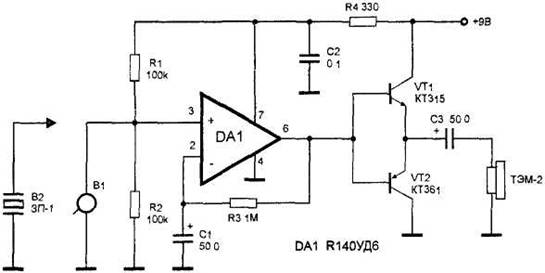
Figure 28. Microphone-the stethoscope.
The audio frequency amplifier is assembled on a chip DА1 type COD. Resistors R1 and R2 set the operation mode of the chip. The gain is determined by the resistance value of the resistor R3. Transistors VT1 KT315 type and type VT2 KT361 included as emitter followers and amplify the output signal current. The load of the amp head phones TEM-2. The vibration sensor is made from a piezoceramic heads B1, taken from an old player. Vibratoire converted by the piezoelectric transducer in electrical and amplified by amplifier DA1. As a piezoelectric transducer B2 can be applied system type SN-1, SN-22 and similar from electronic watches and toys. They well reproduce the frequency range 800-3000 Hz, which largely overlaps the speech frequency range. If needed, you can boost the signal to the desired value, using an additional amplifier of sound frequency. The signal it's receiving from the output of the operational amplifier DA1. Such a sensor can be successfully used as a sensor alarm. As a piezoelectric transducer B1 can be used, for example, PE-1, GSP-308 and others.






